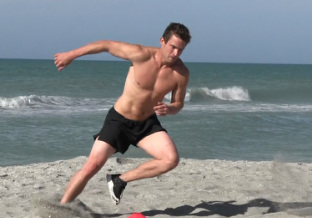The “Slalom Agility Run in Sand” exercise shown in the video is one of the best overall movement exercises for any athlete who is looking to improve his/her ability to change direction quickly – especially in lateral and multi-directional movements. The exercise can be performed on grass, hardcourts, claycourts or sand. The exercise shown is performed on sand and this increases the recruitment of the larger muscles to help the athlete push forcefully into the ground and also stresses the smaller muscles of the lower body to help stabilize during the forceful eccentric muscle actions involved in the deceleration required at each of the cones. Then the athlete needs to push forcefully into the sand to be able to re-accelerate to move to the next cone. This is a challenging exercise for most athletes; it is rather common for athletes to feel some muscle soreness (DOMS) the first 48-72 hours after performing a series of sand movements. Start this exercise performing 6 cones spaced at 10 yards apart in a slalom pattern. Perform 10 repetitions of the sprint from cone 1-6 proving 60-120 seconds rest to work on explosiveness. If using this exercise for tennis-specific endurance work, then perform 20 repetitions with 20-30 seconds rest between each repetition.
|
Exercise: Slalom Agility Run in Sand The “Slalom Agility Run in Sand” exercise shown in the video is one of the best overall movement exercises for any athlete who is looking to improve his/her ability to change direction quickly – especially in lateral and multi-directional movements. The exercise can be performed on grass, hardcourts, claycourts or sand. The exercise shown is performed on sand and this increases the recruitment of the larger muscles to help the athlete push forcefully into the ground and also stresses the smaller muscles of the lower body to help stabilize during the forceful eccentric muscle actions involved in the deceleration required at each of the cones. Then the athlete needs to push forcefully into the sand to be able to re-accelerate to move to the next cone. This is a challenging exercise for most athletes; it is rather common for athletes to feel some muscle soreness (DOMS) the first 48-72 hours after performing a series of sand movements. Start this exercise performing 6 cones spaced at 10 yards apart in a slalom pattern. Perform 10 repetitions of the sprint from cone 1-6 proving 60-120 seconds rest to work on explosiveness. If using this exercise for tennis-specific endurance work, then perform 20 repetitions with 20-30 seconds rest between each repetition.
0 Comments
Announcing an in-person 4-Hour Specialty Course FREE for iTPA and USPTA members. Speed, Agility & Quickness for Tennis: Creative Programming to Add Value To Your On-Court Training. Sunday, June 9th in Mt Kisco, NY from 4 - 8 PM EST. See details below and register today! (If you are an iTPA Member, email us to let us know you are attending).
Event Webpage: www.itpa-tennis.org/agility-course When: Sunday, June 9, 2013 4:00 - 8:00 PM EST Where: Saw Mill Racket Club 77 Kensico Drive Mt Kisco, NY 10549 (914) 241-0797 Price: Complimentary for iTPA and USPTA Members $50 for any individual not a member of iTPA or USPTA *If you are an iTPA Member in good standing and will be attending, please email us here so we can get an accurate head count. You must send us an email in order to attend the event. Worth 50 iTPA CPE credits What: This four hour specialty course will provide specific drills and exercises to develop tennis-specific speed, agility and quickness. Improving tennis-specific movement is paramount to success on the court at every level of the game. The format of the course is designed to allow the participant to learn the best methods and progressions and how to link these drills and exercises with strokes and strategy. The entire course will be on-court and in an interactive format to ensure a full understanding of how these drills and exercises can be implemented into your lesson plans. Come and join your fellow professionals in a unique format that will allow significant interaction and case examples with scenarios that you encounter every day with your players. Worth 50 iTPA Continuing Professional Education Credits and 2 USPTA credits. NO refunds, even if you are not able to attend. The USPTA Eastern is hosting it's annual TennisFest on June 9th and 10th. Information and registration here. While the ITPA was reviewing some in-depth research that has been posted on the ITPA Inner Circle looking at the biological limits to running speed, we thought that it would be important to provide some highlights to help every tennis player from recreational to professional move faster on court. The research on how individuals move fast is limited by two major areas: 1) how much force can be applied to the ground 2) how quickly that force can be applied (i.e. how short a time period the athlete spends on the ground) A new study by Dr. Weyand (Weyand et al. J Appl Physiol 2010) and his research group has found that the time on the ground is truly the limiting factor in an athlete’s speed potential. This simple statement is very important to understand when developing movement for tennis. The training needs to involve generating high forces into the ground while trying to limit the amount of time spent on the ground. Therefore, it is important to develop enough strength in the lower body and core muscles to generate forces into the ground. This should be accomplished through appropriate strength training and supervised by a competent professional. These high forces also need to be moved with high velocity which amounts to an athlete’s ability to generate power: strength X speed or [(force X distance)/time]. When training for tennis-specific movement make sure the speed of movement is emphasized and keep working on developing strength levels so that optimum power can be achieve. Weyand P G et al. J Appl Physiol 2010;108:950-961 |
iTPA Blog
The leader in tennis fitness, performance, education and tennis certification. Get iTPA Certified today! Categories
All
|







 RSS Feed
RSS Feed
